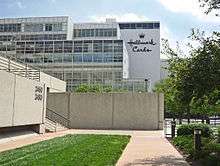Hallmark Cards
 | |
| Private | |
| Industry | Greeting card |
| Founded | Kansas City, Missouri, United States (January 10, 1910) |
| Founder | Joyce Hall |
| Headquarters | 2501 McGee Street, Kansas City, Missouri, United States |
Area served | Worldwide |
Key people |
|
| Products |
|
| Brands | |
| Revenue |
|
| Owner | Hall family |
Number of employees | 16,000 |
| Subsidiaries |
|
| Website |
hallmark |
Hallmark Cards, Incorporated is a privately owned American company based in Kansas City, Missouri. Founded in 1910 by Joyce Hall, Hallmark is the largest manufacturer of greeting cards in the United States.[2] In 1985, the company was awarded the National Medal of Arts.[3]
History



Joyce Clyde Hall became captivated by a salesman who stopped by his family's store in 1906 in Norfolk, Nebraska. Driven by the postcard craze of 1903, Hall decided to venture from retail of various products to wholesale of postcards. He moved his business to the larger market of Kansas City. As time went on, Hall became more convinced that greeting cards would become more prominent than postcards. Greeting cards, according to J.C. Hall, represented class, promised discretion and "they were more than a form of communication—they were a social custom.”
By 1915, the company was known as Hall Brothers and sold Valentine's Day and Christmas cards. In 1917, Hall and his brother Rollie "invented" modern wrapping paper when they ran out of traditional colored tissue paper. In 1922, the company expanded throughout the country.[4] The staff grew from 4 to 120 people, and the line increased from holiday cards to include everyday greeting cards.
In 1928, the company adopted the name "Hallmark", after the hallmark symbol used by goldsmiths in London in the 14th century, and began printing the name on the back of every card. In the same year, the company became the first in the greeting card industry to advertise their product nationally. Their first advertisement appeared in Ladies' Home Journal and was written by J.C. Hall himself.[4] In 1931, the Canadian William E. Coutts Company, Ltd., a major card maker, became an affiliate of Hall Brothers, which was Hall Brothers' first international business venture.
In 1944, it adopted its current slogan, "When you care enough to send the very best." It was created by C. E. Goodman, a Hallmark marketing and sales executive, and written on a 3x5 card.[5] The card is on display at the company headquarters. In 1951, Hall sponsored a television program for NBC that gave rise to the Hallmark Hall of Fame, which has won 80 Emmy Awards.[6] Hallmark now has its own cable television channel, the Hallmark Channel which was established in 2001. For a period of about 15 years, Hallmark owned a stake in the Spanish language network Univision.
In 1954, the company name was changed from Hall Brothers to Hallmark. In 1958, William E. Coutts Company, Ltd., was acquired by Hallmark; until the 1990s, Hallmark's Canadian branch was known as "Coutts Hallmark".
In 1998, Hallmark made a number of acquisitions, including Britain-based Creative Publishing (a recent spinoff of Fine Art Developments), and U.S. based InterArt.[7][8]
Employees
Worldwide, Hallmark has 11,000 full-time employees. About 3,100 Hallmarkers work at the Kansas City headquarters.[1]
Management
The current president & CEO chairman is Donald J. Hall.[1]
Creative resources
Hallmark's creative staff consists of around 800 artists, designers, stylists, writers, editors and photographers. Together they generate more than 19,000 new and redesigned greeting cards and related products per year. The company offers more than 48,000 products in its model line at any one time.
Products and services
Hallmark offers or has offered the following products and services:
Greeting cards
Hallmark Cards feature several brands and licenses. Shoebox, the company's line of humorous cards, evolved from studio cards. Maxine (by John Wagner), was introduced in 1986 when she appeared on several Shoebox cards the year the alternative card line was launched. hoops&yoyo, were characters created by Bob Holt and Mike Adair. Revilo is another popular line, by artist Oliver Christianson ("Revilo" is "Oliver" spelled backwards). Forever Friends was purchased in 1994 from English entrepreneur Andrew Brownsword, who for four years subsequently was Chief Executive of Hallmark Europe. Image Craft was acquired by the William E. Coutts Company subsidiary of Hallmark Canada in the mid-2000s.
Hallmark has provided software for creating and printing cards. This software has been known as Hallmark Card Studio, with partner Nova Development, and Microsoft Greetings Workshop in partner with Microsoft.[9]
Notable changes to their line up has been in August 2008 when Hallmark added same-sex marriage cards. Hallmark also was the first company to recognize Valentine's Day.
Hallmarks Cards is also one of the biggest data mining company in United States.
Gift products
- Gifts, Greeting Cards
- Hallmark Flowers
- Keepsake Ornaments
- Road Rovers: diecast cartoon vehicles[10]
- Books
- Stationery
- Sentimental Frames
- Recordable Plush
- Itty-Bittys
- Bookmarks
Licensors
Hallmark manufactures greeting cards, ornaments, and related gift products from the following licensors:
- 20th Century Fox
- Beatrix Potter
- Cartoon Network
- DC Comics
- Dr. Seuss
- DreamWorks Animation
- Family Guy
- Filstar Distributors Corporation
- Ford Motor Company
- General Motors
- Hanna Barbera
- Harley-Davidson
- Ice Age film series
- Looney Tunes
- Lucasfilm
- Marvel Comics
- Mattel
- MGM
- National Basketball Association
- National Football League
- National Hockey League
- Paws, Inc.
- Peanuts
- Peyo
- Precious Moments, Inc.
- Rankin/Bass
- Sanrio
- Sony Pictures
- Star Wars
- Tervis Tumbler
- The Hershey Company
- The Simpsons
- The Walt Disney Company
- Thomas Kinkade
- Tim Burton
- Ty Inc
- Universal Studios
Hallmark Visitors Center
The Hallmark Visitors Center is located at the company's headquarters in Kansas City, Missouri. The Center features exhibits about the company's history including historic greeting cards and postcards, Christmas ornaments, exhibits from the company's art collection, and displays about the Hallmark Hall of Fame programs and awards.[11] There is also a movie about the company's history.
Hallmark School Store
Alvirne High School in Hudson, New Hampshire, operates the only Hallmark school store in the United States. Besides normal food and beverage items, the "Bronco Barn" store also sells Hallmark cards. The store is run by students in Marketing I and Marketing II classes, and is open to students all day and after school.[12]
Subsidiaries and assets
Hallmark owns:
- Crayola LLC (formerly Binney & Smith): makers of Crayola-brand crayons
- DaySpring Greeting Cards, is the world's largest Christian greeting card company. It was purchased in 1999 from Cook Publishing and is based in Siloam Springs, Arkansas.
- Hallmark Business Expressions: Formed in 1996, Hallmark Business Expressions is a business-to-business subsidiary of Hallmark Cards, Inc. and is headquartered in Kansas City, MO.[13]
- Hallmark Channel: cable television network—Hallmark Cards owns the majority of stock in this publicly traded company (Crown Media Holdings);
- Hallmark Gold Crown: a chain of independently-owned card and gift stores in the United States and Canada. Certain locations are corporate operated.
- Hallmark Business Connections: Incentives—Reward programs, recognition programs and online gift certificates;
- Halls, an upscale department store at Kansas City's Crown Center
- Feeln: A premium subscription video on-demand (SVOD) service that is the exclusive streaming provider of the Hallmark Hall of Fame library of films, along with a curated collection of Hollywood features, TV series and original productions.
- Rainbow Brite: a franchise of children's dolls
- Shirt Tales: a franchise of cards, featuring animals with shirts that read different messages
- Sunrise Greetings: Located in Bloomington, IN
- Zoobilee Zoo: a 1986 TV show, centered a zoo populated by animals with artistic tastes
In addition, Hallmark Cards is the property manager of the Crown Center commercial complex, adjacent to its headquarters, and the owner of lithographer Litho-Krome Co.
Philanthropy
In 2006, Hallmark donated its extensive collection of photographs by prominent photographers including Todd Webb to the Nelson-Atkins Museum of Art in Kansas City.[14]
Hallmark Music
In the Philippines, singer Richard Tan sang a song about Hallmark Cards, entitled "No One Throws Away Memories". The song was featured in a commercial of the product in the 1970s.
In the mid-1980s, the company started its music division, issuing compilation albums by a number of popular artists. In 2004, Hallmark entered into a licensing agreement with Somerset Entertainment to produce Hallmark Music CDs.
Former subsidiaries
- Hallmark Entertainment: a producer of television shows and mini-series. Halmi Jr. and Halmi Sr. acquired the company in 2006 and was absorbed into RHI Entertainment;
- Univision: Hallmark owned Spanish-language broadcaster Univision from 1986 to 1992[15]
Hallmark photographic collection
The Hallmark Photographic Collection was donated to the Nelson-Atkins Museum of Art in Kansas City, Missouri.
Legal problems
Neil Armstrong sued Hallmark Cards in 1994 after they used his name and a recording of his quote, "That's one small step for a man, one giant leap for mankind" in a Christmas ornament without permission. The lawsuit was settled out of court for an undisclosed amount of money which Armstrong donated to Purdue University. The case caused Armstrong and NASA to be more careful about the use of astronaut names, photographs and recordings, and to whom he had granted permission. For non-profit and government public-service announcements, he would usually give permission.[16]
On September 6, 2007, Paris Hilton filed an injunction lawsuit against Hallmark Cards Inc. in U.S. District Court over the unlawful use of her picture and catchphrase "That's hot" on a greeting card. The card is titled "Paris's First Day as a Waitress" with a photograph of Hilton's face on a cartoon of a waitress serving a plate of food, with a Hilton's dialogue bubble, "Don't touch that, it's hot." (which had a registered trademark on February 13, 2007). Hilton's attorney Brent Blakely said that the infringement damages would be based on profits from the $2.49 greeting cards. Julie O'Dell said that Hallmark used the card as parody, protected under fair use law.[17]
See also
References
- 1 2 3 "Hallmark Corporate Information | Hallmark Facts". Corporate.hallmark.com. Retrieved 2016-11-19.
- ↑ "Hallmark Cards - Joyce Hall Invented Hallmark Cards". Inventors.about.com. Retrieved 2016-11-19.
- ↑
- 1 2 "Early Innovation 1910s–30s". Hallmark Corporate. Retrieved June 8, 2011.
- ↑
- ↑
- ↑ "Hallmark Cards agrees to buy British competitor". Southeast Missourian. Associated Press. July 10, 1998.
- ↑ "Hallmark buys firm". Victoria Advocate. September 11, 1998.
- ↑ "Microsoft and Hallmark Connections Team Up to Offer Microsoft Greetings Workshop" (Press release). Microsoft. September 11, 1996. Retrieved October 1, 2010.
- ↑ "Hallmark Road Rovers". Jubys.com. Retrieved 2016-11-19.
- ↑ "Official site". Hallmark Visitors Center. Retrieved 15 November 2015.
- ↑ "alvirnehs.org". Alvirnehs.org. Retrieved 2016-11-19.
- ↑ Carol Krol (October 16, 2006). "Marketers find opportunities for better targeting ROI". btobonline.com. Retrieved October 1, 2010.
- ↑ Shattuck, Kathryn (February 18, 2006). "For a Dear Museum: Love, Hallmark". The New York Times. Retrieved October 10, 2010.
- ↑ "Facts about Hallmark's Major Subsidiaries". Archived from the original on October 13, 2007.
- ↑ Hansen, James R. (2005). First Man: The Life of Neil A. Armstrong. Simon & Schuster. p. 628. ISBN 0-7432-5751-0.
- ↑ "Paris Hilton Sues Over Hallmark Card". The Smoking Gun. September 7, 2007. Retrieved December 12, 2008.
External links
| Wikimedia Commons has media related to Hallmark Cards. |